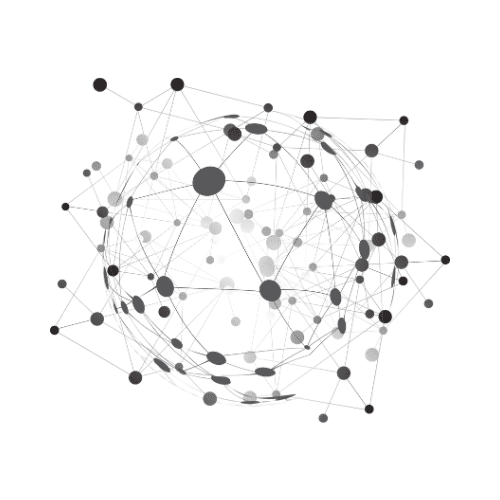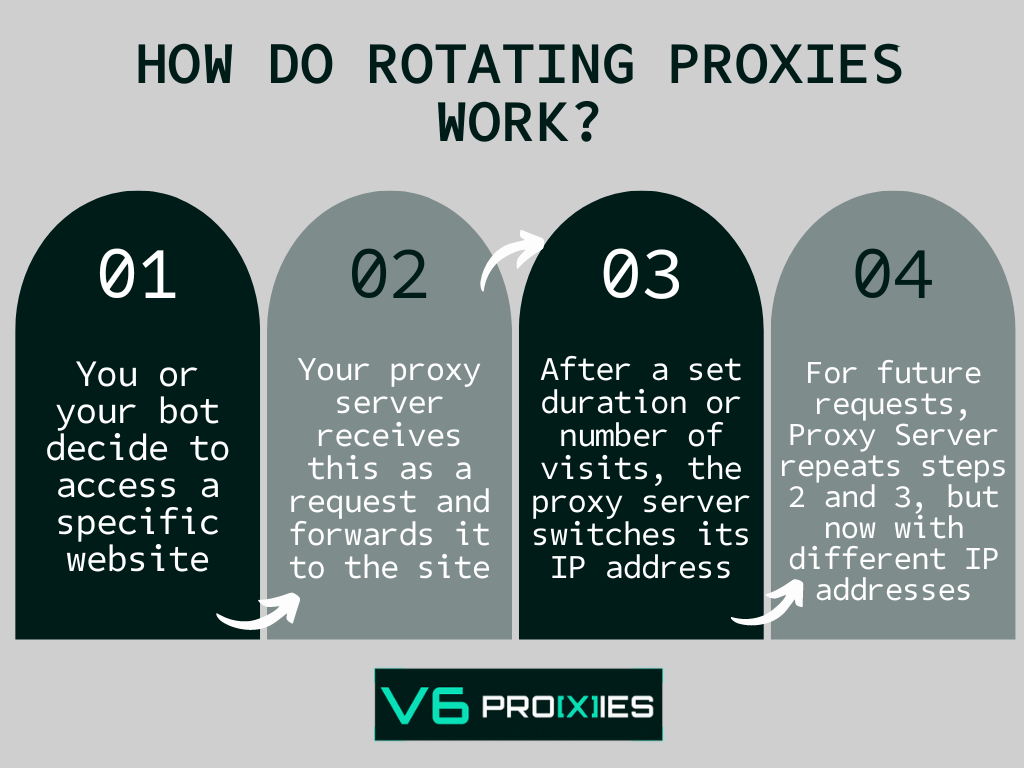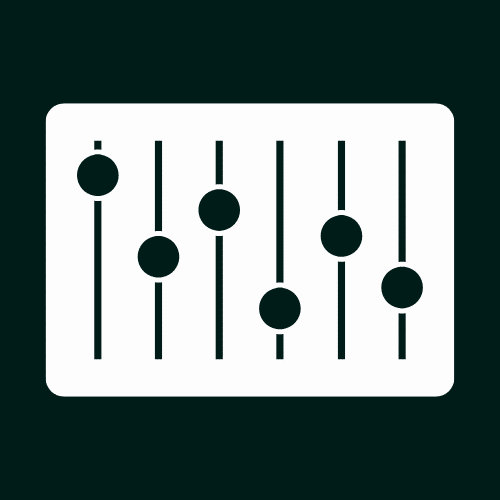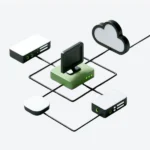What is a rotating proxy? Why does it exist as a method and what is its purpose? In a new proxy glossary episode, we dive into the world of proxy IP rotation to define it, get to know its use cases and answer all related questions using simple analogies and examples.
Table of Contents
- What is a Rotating proxy? A simple definition
- How do rotating Proxies work?
- How can you use a rotating proxy? settings and configuration
- Challenges proxy rotation face
- Proxy rotation in action (practical use cases)
- Answers for questions you might still have
- Looking for an efficient proxy rotation management service?
What is a Rotating proxy? A simple definition
Proxy rotation is a method where proxy systems switch IP addresses to avoid being detected by a server.
To understand the definition, imagine the internet as a grand library and each book or section as a different website. Now, there’s a librarian (the server) who’s wary of people (IP addresses) borrowing too many books or revisiting the same section too often, thinking they might damage or hoard the information.
Proxy rotation is like changing your appearance (using a different hat or coat) each time you visit the library. With a new look (IP address), the librarian doesn’t recognize you from your previous visits, allowing you to access more books or revisit sections without drawing suspicion.
The primary purpose of rotating proxy
The chief reason for using rotating proxies is to avoid IP detection, banning and blocking when accessing a website multiple times. It’s particularly vital for tasks like web scraping where you need to visit a site frequently.
By rotating proxies, you can keep collecting data without the site catching on and shutting you out. It’s a blend of disguise and strategy to navigate the vast internet smoothly.

How do rotating Proxies work?
To understand how rotating proxies work, you need to first get two concepts:
- IP addresses: Each device connected to the internet has a unique address.
- Servers: acting as the guardians of websites, recognize visitors by these IP addresses.
Proxy rotation works by frequently changing these IP addresses so that a visitor appears new every time. This frequent change happens through a process of 3 steps:
1- You or your bot decide to access a specific website.
2- Your proxy server, the intermediary, receives this as a request and forwards it to the site.
3- After a set duration or number of site visits, the proxy server switches its IP address to prevent IP Blocking that arises from frequent visits.
4- The next time you make a request, steps 2 and 3 are repeated, but now with a different IP address from the proxy’s pool.
This process ensures the target website sees visits coming from varied sources, rather than one constant visitor.

How can you use a rotating proxy? settings and configuration
Proxy rotation settings involve defining parameters like which IPs to use, when to switch them, and how to manage any errors that might arise during the process. This brings us to know these important terms and considerations:
Proxy rotation intervals
This dictates how often the IP address should change. This can be:
- Time-based: (e.g., every 30 minutes)
- Request-based: (e.g., after every 10 website accesses).
IP selection settings
When you think of IP selection configuration consider these two factors:
- Geographical Distribution: Select IP addresses from specific regions or countries based on the target websites you’re accessing.
- IP Type: Decide between shared or dedicated IPs. Shared IPs are used by multiple users, while dedicated IPs are reserved for one user.
IP rotation error handling
Always ensure your settings or your proxy provider service include:
- A Retry Logic: Set up a system to retry a request if it initially fails.
- Fallback IPs: Designate backup IPs to use if the primary ones get blocked.
Proxy rotation bandwidth and speed
To achieve your targets from using the rotating proxy make sure your settings include:
- A throttle rate: this controls the speed of your requests to avoid overloading a server.
- Concurrent connection settings: Determine how many simultaneous connections you want to make with the target server.
Rotation security and encryption settings
To ensure a secure data transmission between you and the proxy server, you should:
- Use SSL encryption
- Set a trusted authentication system for connecting with the rotating proxy server.
Logging and monitoring Proxy rotation processes
There are 2 main logs you should keep and monitor:
- Rotation activity Logs: Monitor which IP addresses are being used and when.
- Rotation Error Logs: Track failed requests to help refine the process.
Sticky sessions setting
As some websites need user login sessions, you might need to to use the same IP for multiple related site visits. Configuring sticky sessions ensures continuity when you deal with that.
To paint a clearer picture with an analogy:
Consider rotating proxy settings as setting up a sophisticated home automation system.
You’re not only determining when the lights turn on or off (rotation intervals) but also choosing the brightness (bandwidth), setting up alarms if a door is left open (error handling), or even selecting a particular theme for a movie night (geographical IP selection). The finer details make the experience smooth and efficient.

Challenges proxy rotation face
Even with the best setups, proxy rotation can face some hurdles and challenges. Addressing these ensures a smoother and more efficient experience.
These challenges include:
- IP pool exhaustion: Using a limited Proxy pool can quickly lead to all IP addresses getting recognized and blocked.
- IP initial blocking: Some IP addresses might be blacklisted or considered spammy by target servers, rendering them useless. Ensure you avoid that with us.
- Need for ongoing maintenance: Proxy services best providers like V6proxies regularly update and prune the IP pool to ensure it’s fresh and effective.
- Failed Rotations: Not every IP switch will be successful. There might be connectivity issues, or the new IP might get immediately flagged. When this happens your system should implement:
- Immediate Detection
- Quick Recovery by switching to a working IP to maintain service continuity.
- Documentation of failed rotations to identify patterns and refine the process.
Proxy rotation in action (practical use cases)
Proxy rotation isn’t just a technical marvel; it has real-world applications that many industries rely on. Here are some practical scenarios.
Web Scraping and Data Mining
What happens: Businesses collect and scrape vast amounts of data from websites for analysis. If they use a single IP address, it can get banned for making too many requests.
Proxy Rotation’s Role: By changing IPs frequently, they can continue collecting data without interruptions.
Ad Verification
What happens: Companies want to ensure their ads are displayed correctly across regions and aren’t being fraudulently clicked.
Proxy Rotation’s Role: Using proxies from different regions helps verify ads’ proper display and authenticity.
SEO Monitoring
What happens: SEO experts need to check search engine rankings in different regions.
Rotation’s Role: Rotating proxies allow them to see results as if they were located in various parts of the world.
Online Gaming
What happens: Gamers sometimes face regional restrictions or want to play on international servers.
Rotation’s Role: Using rotating proxies, they can switch regions and enjoy games without geo-blocks.
E-commerce and Price Comparisons
What happens: Shoppers want to compare prices across regions, or businesses want to monitor competitors’ prices.
Rotation’s Role: Rotating proxies allow access to regional prices without the website detecting and possibly altering the displayed price.
Answers for questions you might still have
How Often Should IPs Rotate?
The ideal rotation frequency varies based on the task. For example, high-frequency tasks like web scraping might need quicker rotations than casual browsing.
Can Rotating Too Frequently Cause Issues?
Yes, over-rotation can be counterproductive due to these risks:
- Detection: Websites might detect unusually high IP switches and flag them as suspicious.
- Efficiency Loss: Too frequent changes can slow down operations as each switch can add a minor delay.
- Resource Drain: Rapid IP changes can consume more resources.
[SMTP Proxies] A-Z Guide & Answers To All FAQs
Looking for an efficient proxy rotation management service?
Dive into V6 Proxies unique approach to proxy services. Tailored, reliable, and designed to fit every budget, we redefine what it means to offer a seamless proxy experience via:
- Custom-Designed Plans: Our services are categorically structured, ensuring a tailored experience akin to getting a suit stitched to your exact measurements.
- Minimalist Approach: We optimise our offerings to provide essential, reliable services without overwhelming choices.
- Budget-Friendly: Rent specific proxy spaces, ensuring cost-effective solutions. It’s like a buffet where you only pay for what you take.
- Versatile Proxy Options: Whether IPv4, IPv6, residential, datacenter, or combinations, we cater to all your needs.
- Tags:
- web scraping


